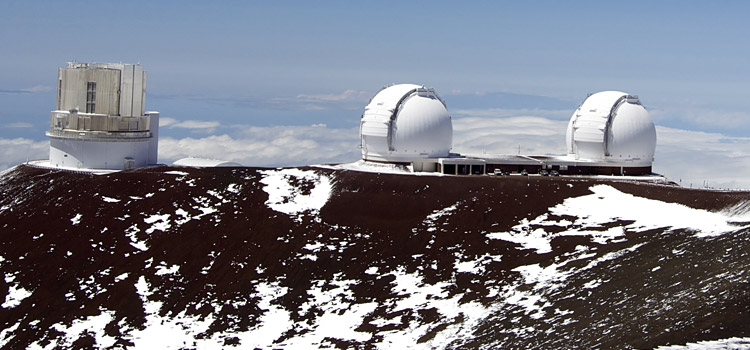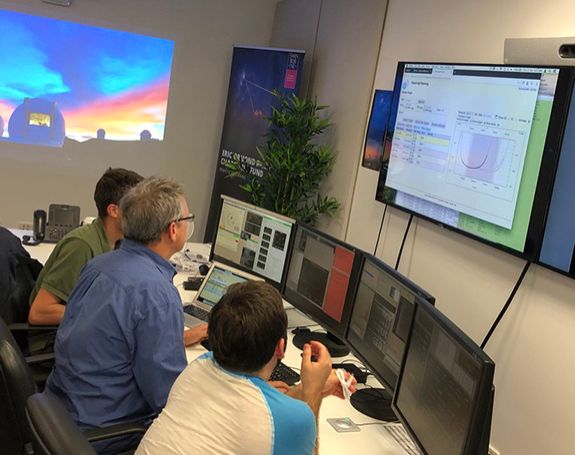Reducing carbon emissions in astronomy

Swinburne's access to the W M Keck Observatory, atop Mauna Kea in Hawai’i, was detailed in a study assessing carbon emissions in astronomy. The mountain is adjacent to Mauna Loa, the premier site in the world for measuring atmospheric carbon dioxide levels. Credit: Dr Adrian Malec.
In summary
- A new study sheds light on carbon emissions produced by the Australian astronomical community
- The study makes recommendations for reducing the impact of conducting research on our planet
- Since the study was conducted, Swinburne has reduced its overall carbon emissions by 70 per cent
Many aspects of being an astronomer result in the emission of greenhouse gases that contribute to climate change. These include direct emissions from flights, and indirect emissions from the electricity required to power supercomputers, observatories and other facilities.
A study published in Nature Astronomy sheds light on carbon emissions produced by the Australian astronomical community and makes recommendations for how astronomy and other industries can carry out cutting-edge research with a reduced impact on our planet.
The new study, led by Swinburne alumni Dr Adam Stevens and Dr Sabine Bellstedt, and including Professor Michael Murphy from the Centre for Astrophysics and Supercomputing (CAS), found that the work-based emissions of the average Australian astronomer are equivalent to around 37 tonnes of carbon dioxide per year.
On a per-capita basis, this is 40 per cent higher than the average Australian adult and five times the global average.
Carbon emissions at the Centre for Astrophysics and Supercomputing
The study found that the use of Swinburne’s OzSTAR supercomputer – used for astrophysical simulations and processing astronomical data – was by far CAS’s largest carbon emissions source, followed by air travel, then emissions from electricity use in on-campus workplaces.
Another important factor, but one that is difficult to estimate, Professor Murphy says, is the carbon emissions from CAS’s use of world-wide astronomical observatories.

“We are very fortunate to have access to the W M Keck Observatory in Hawai’i through a collaborative agreement with Caltech in the USA, but of course we then share in the carbon emissions for operating these amazing telescopes. However, our audit found this is a relatively small part of CAS’s carbon budget at present.
"We are also travelling to Hawai’i less often after installing the world's most remote observing facility on our Hawthorn campus."
Reducing emissions at Swinburne
Since the study was conducted, Swinburne has signed a contract with Infigen Energy to procure 100 per cent renewable electricity from July 2020. This will drastically reduce Swinburne’s carbon footprint as emissions from our electricity represent more than 70 per cent of our total emissions.
This includes the OzSTAR supercomputer as well as carbon emissions from office electricity use.

At the time of the study, the OzSTAR supercomputer was being powered by electricity from Victoria's brown-coal-dominated grid. It is now powered by 100 per cent renewable electricity.
“Members of CAS were strong proponents of the move to 100 per cent renewable electricity in Swinburne, primarily because our supercomputing needs have such large electricity requirements,” Professor Murphy says. “This single action has likely reduced CAS's carbon emissions by more than 80 per cent, based on pre-COVID–19 figures.”
Reducing air travel emissions will be more difficult. Professor Murphy says that a positive outcome from the current pandemic may be the long-term reduction of air travel for conferences and meetings as the quality and experience of virtual conferences improves.
He adds that every profession has a responsibility to understand and reduce its carbon footprint, and astronomy is no exception.
“We've now completed an initial audit of Australia's astronomy carbon emissions, so we know very well how to reduce them. We just need to get on with it and many astronomy institutes around the country are well on their way."
-
Media Enquiries
Related articles
-

- Astronomy
High school students work with Swinburne astronomers on the future of space
Swinburne’s Youth Space Innovation Challenge has inspired over 330 Australian teenagers to pursue a career in STEM.
Friday 26 July 2024 -

- Astronomy
- Science
Swinburne appoints new Director of Innovative Planet Research Institute
Leading geodesy expert, Professor Allison Kealy, has been appointed as the inaugural Director of Swinburne University's Innovative Planet Research Institute.
Monday 22 April 2024 -

- Astronomy
- University
OzGrav 2.0: A ‘new era of astrophysics’ launched at Swinburne
The next phase in the world-leading ARC Centre of Excellence for Gravitational Wave Discovery, dubbed 'OzGrav 2.0', launched this week at Swinburne University of Technology.
Wednesday 17 April 2024 -

- Design
- Astronomy
- Technology
- University
Swinburne ‘Rock Muncher’ takes part in Australian Rover Challenge
A multidisciplinary student team from Swinburne University of Technology competed in the 2024 Australian Rover Challenge held in Adelaide, South Australia.
Thursday 11 April 2024 -
.jpeg/_jcr_content/renditions/cq5dam.web.256.144.jpeg)
- Astronomy
New JWST observations reveal black holes rapidly shut off star formation in massive galaxies
New research showcases new observations from the James Webb Space Telescope that suggest black holes rapidly shut off star-formation in massive galaxies by explosively removing large amounts of gas...
Tuesday 23 April 2024

